Physical Address
304 North Cardinal St.
Dorchester Center, MA 02124
![]() For video accompanying this chapter see ExpertConsult.com. See inside cover for access details.
For video accompanying this chapter see ExpertConsult.com. See inside cover for access details.
This chapter addresses the practical management of congenital and acquired eyelid conditions. The main indications for eyelid surgery in children are to optimize the potential for useful vision in severe congenital malformations, to prevent amblyopia, to control exposure and breakdown of the ocular surface, and to improve cosmesis. These aims are often aligned, as reconstructive lid surgery usually results in both improved functional and cosmetic outcomes.
Complex cases require a carefully formulated treatment plan. However, flexibility is often required in oculoplastic surgery as surgical plans may need to be modified depending on intraoperative findings.
Eyelid colobomas are embryologic clefts that can range in size from a small notch to a full-thickness defect involving the entire width of the eyelid. The most common position for an eyelid coloboma is at the junction of the medial and middle third of the upper lid. While upper eyelid colobomas can be isolated anomalies, a full ocular examination is needed to exclude associated ocular and systemic abnormalities that can be associated with eyelid colobomas, such as Goldenhar syndrome ( Fig. 17.1 ) or Treacher Collins syndrome.
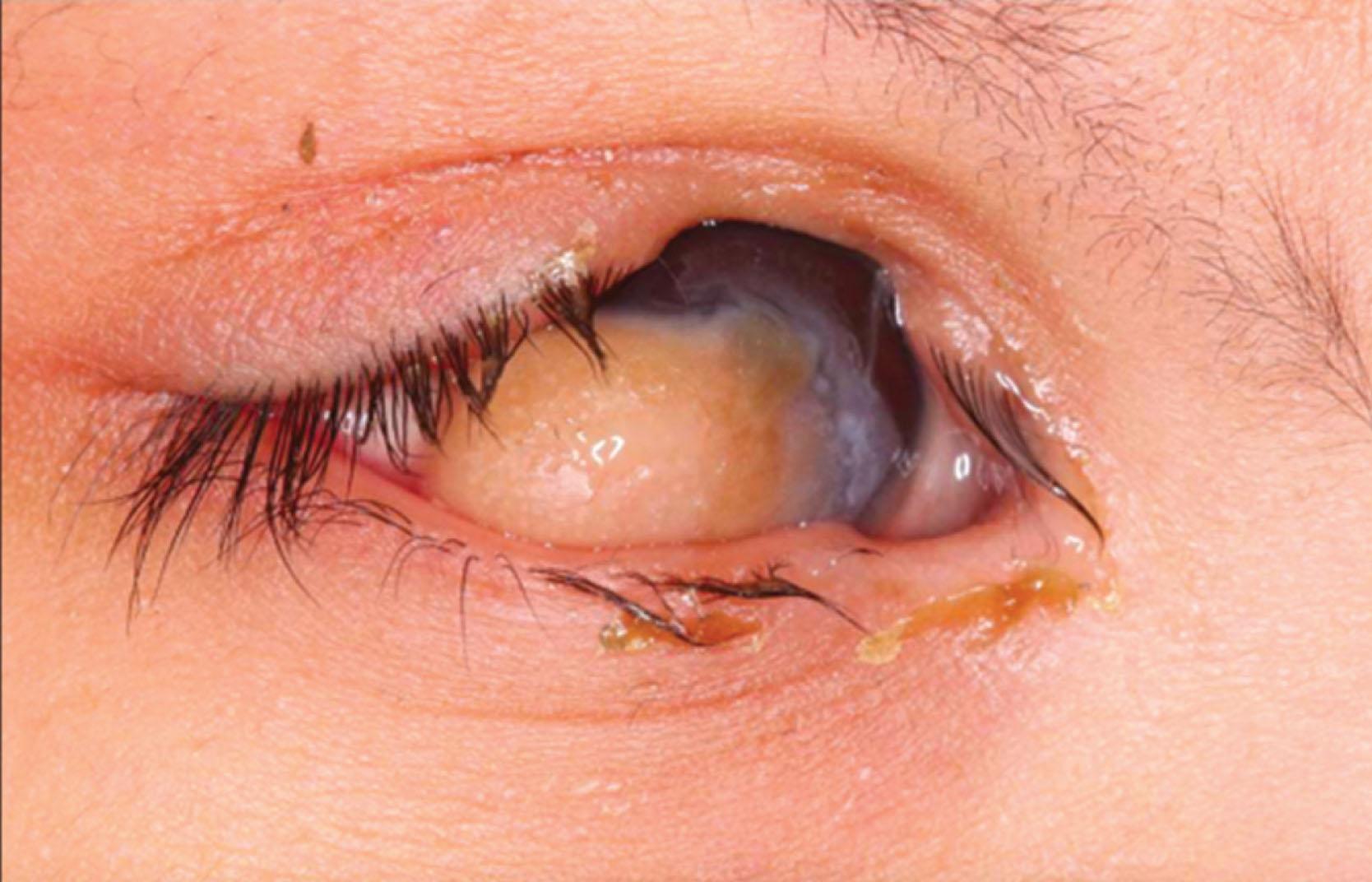
The treatment of lid coloboma is directed toward addressing symptomatic and sight-threatening corneal exposure, preventing amblyopia, and improving cosmesis. Lack of protective eyelid tissue can predispose the cornea to exposure, resulting in opacification and visual loss, including blindness. Surgery, therefore, can be necessary to restore eyelid function and ocular surface protection. The timing of correction depends on the size and location of the defect. Patients with smaller defects may be able to delay surgery for years with aggressive topical lubrication, which allows for growth of soft tissues, increasing options for advancement and closure. However, earlier intervention is often suggested for patients with significant corneal exposure, large defects or bilateral colobomas.
A defect of less than 25% of the eyelid width can frequently be repaired by excision of the coloboma margins and direct closure. For defects of 25%–50% of the eyelid width, a lateral canthotomy and cantholysis – with or without Tenzel style rotation advancement flap – allows the wound edges to come together under reduced tension for layered closure. For defects of 50% or greater, tissue may need to be grafted or recruited from a nonadjacent location. In the lower eyelid, the posterior lamella can be reconstructed using a free tarsal graft from the upper lid, together with myocutaneous advancement for the anterior lamella. Another option for posterior lamella reconstruction is the Hughes tarsoconjunctival flap from the upper lid. This procedure results in temporary occlusion of the visual axis; therefore, the timing of this surgery and length of occlusion should be considered to prevent amblyopia. In the upper eyelid, defects may be closed similarly using a free tarsal graft and myocutaneous advancement flap. Another option is the Cutler–Beard procedure, where an incision is made below the lower eyelid tarsus, and a full-thickness lower eyelid flap is moved into the defect of the upper eyelid by advancing the flap behind the remaining lower eyelid margin. This procedure also results in temporary occlusion of the visual axis. The timing of techniques that require long-term occlusion of an eye during the critical early stage of development should be considered to prevent occlusion amblyopia.
In Treacher Collins syndrome (see Chapter 26 ), eyelid abnormalities include canthal dystopia, true eyelid colobomas, and pseudocolobomas. A pseudocoloboma typically occurs on the lateral lower lid and is a defect of hypoplastic subcutaneous tissue including absence of the lateral canthal tendon. Severe eyelid colobomas may require craniofacial surgery prior to eyelid surgery in order to re-establish malar support. Depending on the extent of the deformity, orbicularis transposition, skin grafting, Z-plasty, and/or canthopexy can be performed for correction of pseudocolobomas.
Cryptophthalmos is a rare condition in which the upper eyelid and eyebrow fail to develop and the cutaneous epithelium is continuous with conjunctiva at the superior fornix. This is usually associated with severe dysgenesis of the anterior segment. The condition can be complete, incomplete, or partial (congenital symblepharon) (see Chapter 29 ).
With complete cryptophthalmos ( Fig. 17.2 ) achieving useful vision is typically not possible, even with extensive reconstructive surgery. With incomplete cryptophthalmos ( Fig. 17.3 ) some cases are amenable to achieving functional vision and reasonable cosmesis, but this is relatively unusual. The same concerns pertain as in eyelid colobomas in regard to operative timing. The urgency of surgery depends on whether the condition is unilateral or bilateral, the presence of visual potential, and the degree of corneal exposure. If the condition is unilateral, no visual potential exists, and exposure is controlled, surgery may be delayed to allow for maturation and easier recruitment of adjacent tissues for reconstruction.
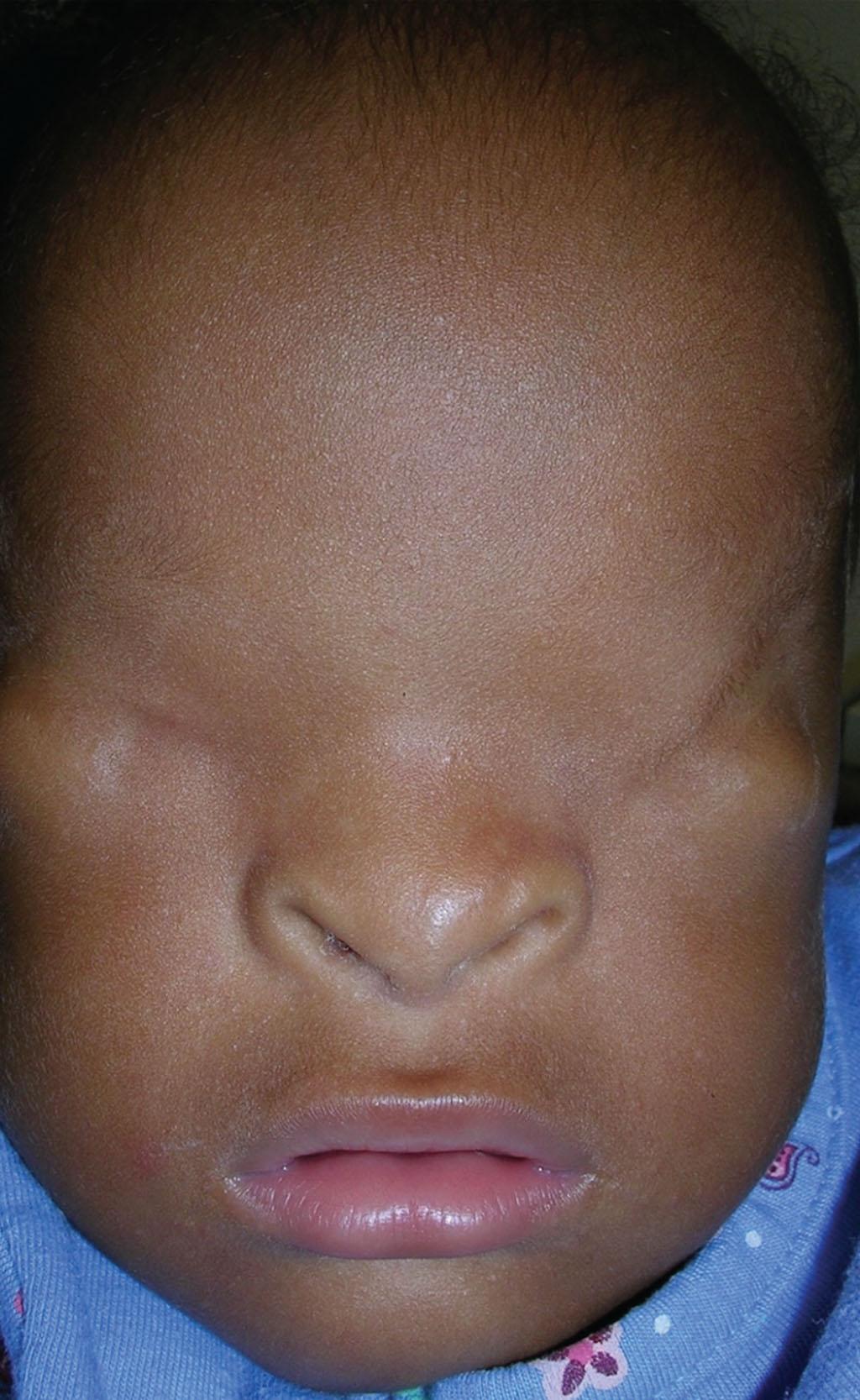
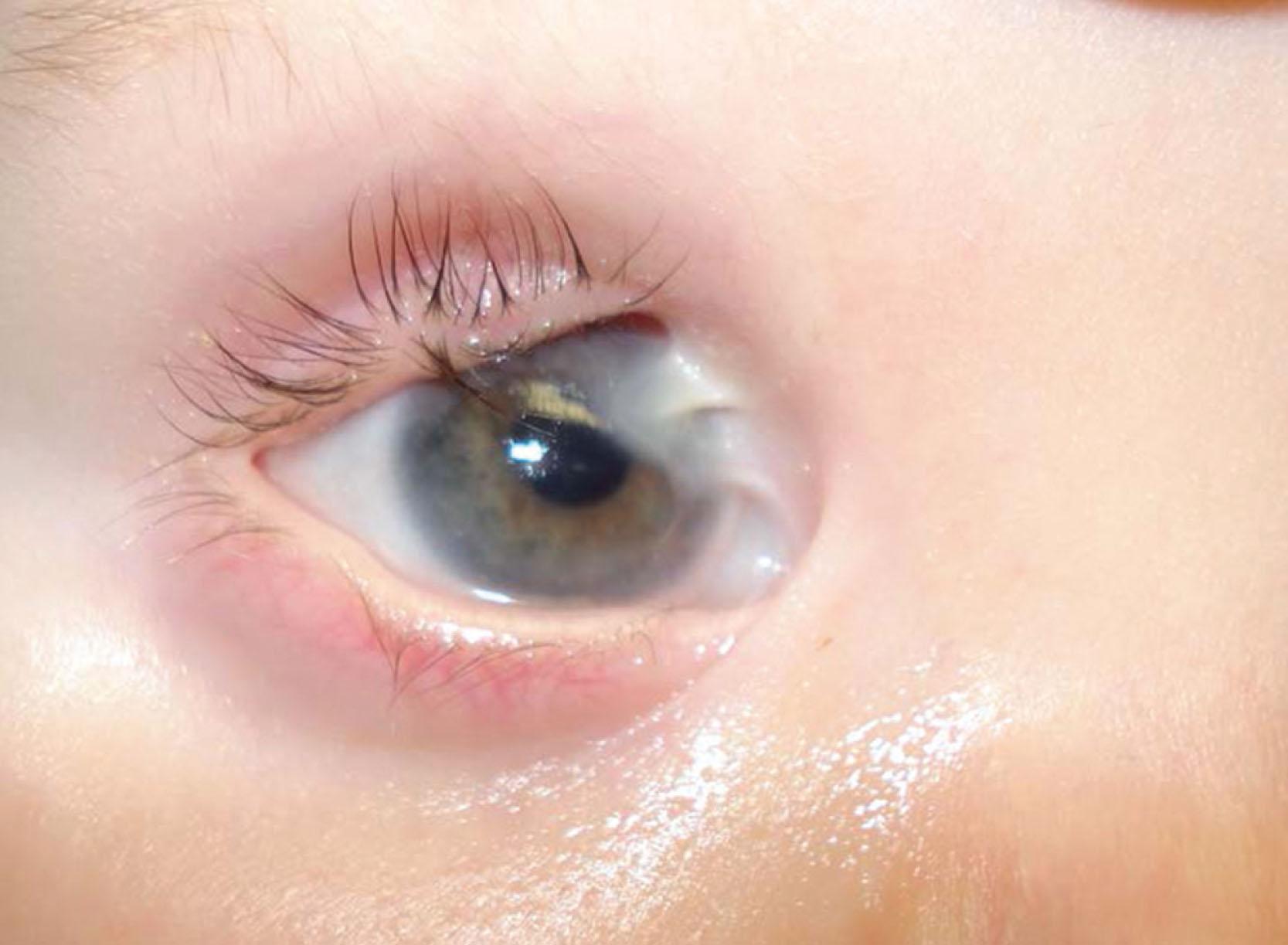
Surgery aims to reconstitute the components of the anterior and posterior lamellae. Pedicle rotation flaps from the cheek or brow, eyelid sharing, full-thickness skin grafts, and mucous membrane grafts are all useful reconstructive tools. The success of complex lid reconstruction is often limited by diminished tear production, paucity of healthy conjunctiva, and underlying ocular defects associated with the condition, such as corneal and anterior segment dysgenesis.
Complete failure of eyelid development is rare. Urgent treatment is required to protect the ocular surface followed by early lid reconstruction. The results depend on the severity of the lid changes and the integrity of the underlying structures. Treatment of true ablepharon typically has poor results; however, treatment of milder cases (microblepharon) is often more successful. Although the eyelid may open minimally initially due to “bow-stringing” of the tight eyelid, this improves significantly within 6−8 weeks of surgery.
Ankyloblepharon is partial or complete fusion of the eyelids by webs of skin which can reduce the palpebral aperture. Ankyloblepharon most commonly occurs sporadically, but can be acquired or familial and occur in association with cleft lip and cleft palate. Ankyloblepharon filiforme adnatum is a similar condition in which one or more skin tags join the two lids and there is usually a normal horizontal palpebral aperture: it is treated by division of the tag or tags.
Ankyloblepharon is easily differentiated from blepharophimosis, in which the palpebral aperture is reduced and there is telecanthus, but the eyelid margins are normal. Recognition of ankyloblepharon necessitates systemic examination to detect potentially associated genitourinary and cardiac abnormalities, as well as syndactyly. The lids may then be opened along the line of fusion with scissors or a scalpel. A thin strip of skin and orbicularis may be excised and the lid margin allowed to conjunctivalize in order to prevent vellus hairs from irritating the ocular surface. The lid structure and tarsus are usually otherwise normal.
Euryblepharon is congenital primary horizontal enlargement of the palpebral aperture, usually most pronounced laterally. There is a localized outward and downward displacement of the lateral canthus along with downward displacement of the lower lid ( Fig. 17.4 ). Mild cases may require no treatment or simple lubrication. If there is a danger of corneal exposure, the lower lid may be resuspended, typically by repositioning the lateral canthus. If the eyelid is vertically deficient, skin grafts and/or posterior lamellar spacer grafts with overlying soft tissue advancement may be required.
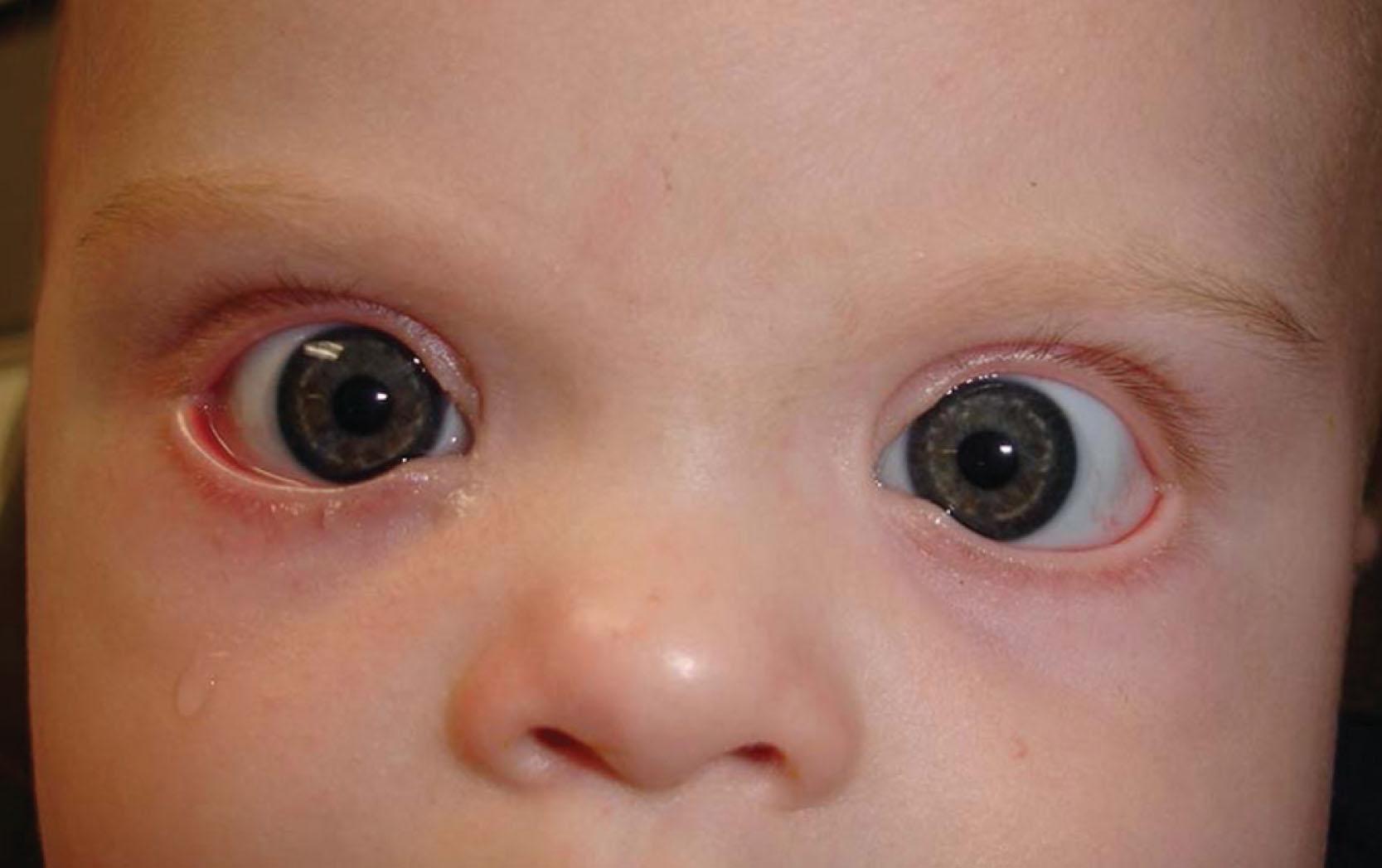
Epiblepharon is characterized by a horizontal skin fold parallel to the edge of the eyelid, typically affecting the lower lid. The lid margin typically remains in a normal position, however, the pretarsal orbicularis and eyelid skin can override the lower lid margin often resulting in posterior ciliary rotation and eyelash–cornea touch. The two known causes of lower eyelid epiblepharon are inadequate lower lid retractor development, marked by the absence of adhesion to the skin, and a pretarsal orbicularis muscle inserted too closely to the lid margin.
Epiblepharon occurs most commonly in Asian children and often resolves by 5−6 years of age as the facial bones mature, exerting increased tension on the eyelid retractors. Symptoms are often minimal in younger children with soft lashes and it is seldom associated with frank keratitis ( Fig. 17.5 ). Surgical intervention is reserved for symptomatic patients who are deemed unlikely to outgrow the condition with conservative measures such as lubrication. Quickert sutures may be used in milder cases, but definitive treatment is with excision of an ellipse of skin and orbicularis muscle with or without tarsal fixation of the eyelid retractors (Celsus procedure).

Epicanthus is a medial canthal fold of skin that may lead to pseudoesotropia due to decreased scleral visibility nasally. It is easily differentiated from true esotropia based on evaluation of the corneal light reflexes. There are four morphologic classifications of epicanthal fold: epicanthus tarsalis, epicanthus inversus, epicanthus palpebralis, and epicanthus superciliaris. Epicanthus tarsalis, which involves a skin fold that is more prominent in the upper eyelid, is a frequently encountered normal variant in Asian eyelids. Epicanthus inversus involves a fold that is most prominent in the lower eyelid and is frequently associated with blepharophimosis–ptosis–epicanthus inversus syndrome (BPES). Epicanthus palpebralis involves the upper and lower eyelids equally. Epicanthus superciliaris involves a skin fold that extends from the eyebrow to the tissue overlying the lacrimal sac. The fundamental difference between epicanthal folds and epiblepharon is that the former are caused by a relative shortage of skin where the soft tissue is stretched between the affected medial eyelid and medial canthus instead of following the contour of the nasal angle.
Epicanthus may become less apparent with time with growth of the facial bones. Therefore, observation is typically recommended pending maturation. Epicanthal folds only require urgent treatment under the rare circumstances that they are associated with trichiasis or vision obstruction. Surgical correction can be undertaken with a Y–V-plasty or variations of Z-plasty in order to address regions of tissue shortage.
Ectropion is an outward rotation of the eyelid margin. The initial treatment of ectropion in childhood is often conservative, using lubrication to address symptoms associated with ocular surface exposure. Surgery is aimed at treating the underlying cause, whether this be vertical shortage of skin or increasing lateral lid laxity, and is usually delayed until the child is older and has more soft tissue with which to work. Ectropion associated with a shortage of skin occurs in congenital conditions such as Down syndrome (see Fig. 17.4 ), blepharophimosis, and acquired conditions such as ichthyosis ( Fig. 17.6 ), dermatomyositis, and trauma. A localized scar can be lengthened with a Z-plasty, and a generalized shortage of skin corrected with a skin flap or graft. Increased lid laxity is treated with lid-tightening procedures such as lateral tarsal strip.
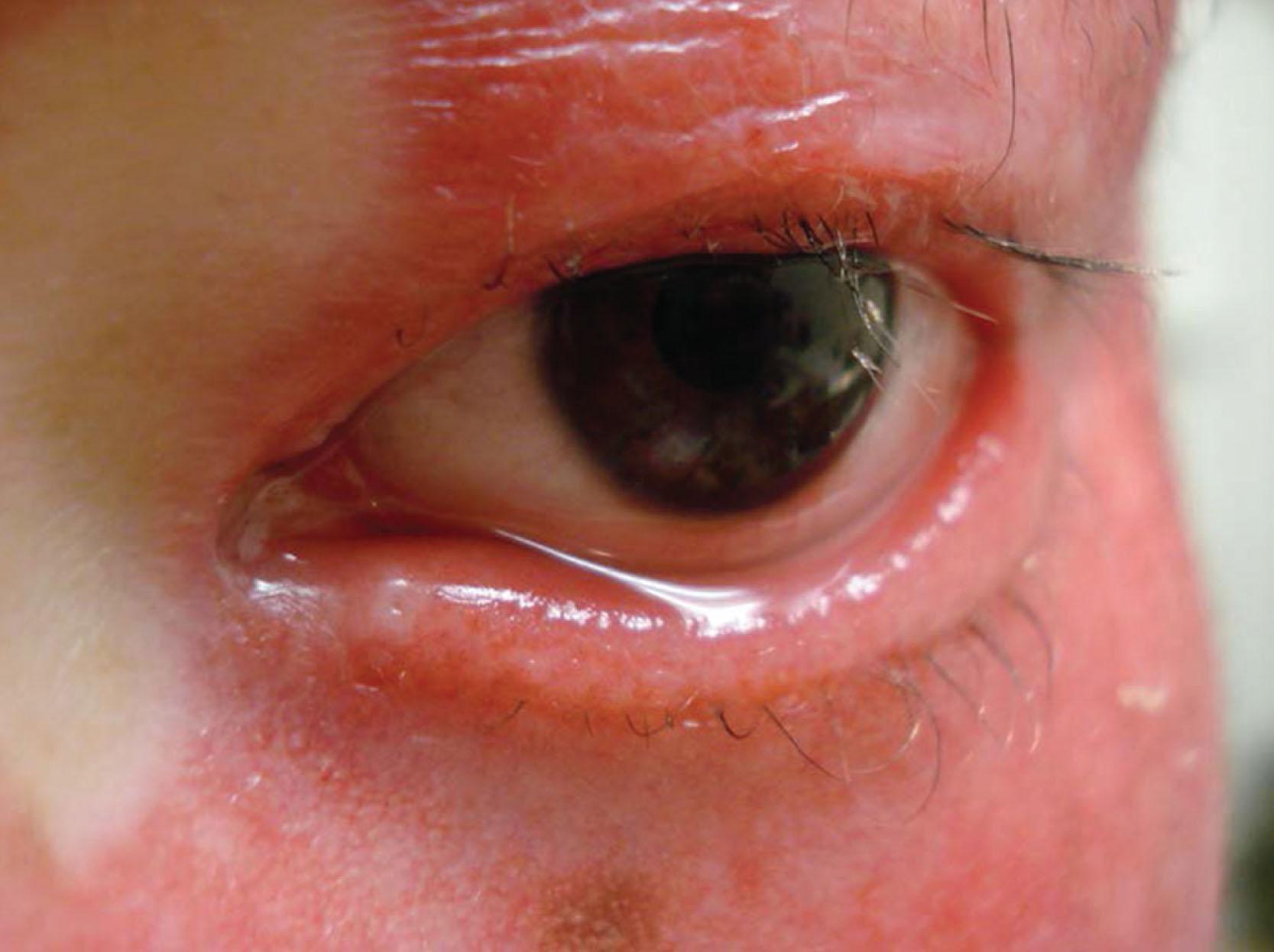
Eversion of the upper eyelids with conjunctival chemosis and prolapse is a rare condition in neonates. The underlying cause of the disorder remains largely unknown, yet several possible mechanisms have been postulated. Birth trauma, orbicularis muscle hypotonia, vertical shortening of the anterior eyelid lamella or vertical elongation of the posterior eyelid lamella, lateral elongation of the lid, failure of the orbital septum to fuse with the levator aponeurosis, and absence of an effective lateral canthal ligament have been implicated as probable underlying causes.
Treatment of congenital eyelid eversion is aimed at repositioning the everted eyelids so that the underlying soft tissue swelling and chemosis can resolve. Once the associated edema has resolved, the eyelids typically remain in proper position unless impacted by other abnormalities. Repositioning the eyelids with pressure patching or taping is usually sufficient. Surgical treatment is indicated for non-resolving cases or those presenting late. These include temporary tarsorrhaphy, fornix sutures, full-thickness skin grafts, horizontal eyelid shortening and excision of redundant conjunctiva.
True congenital entropion of the eyelid margin is rare and presents as an inverted lid margin since birth ( Fig. 17.7 ). This often requires prompt surgical intervention to prevent corneal infection and scarring. It should be distinguished from epiblepharon, where a skin fold causes a secondary in-turning of the lower lid lashes. Surgery is directed toward everting and stabilizing the eyelid with orbicularis debulking, reinsertion of the lower eyelid retractors to the inferior border of the tarsus, and horizontal eyelid shortening.
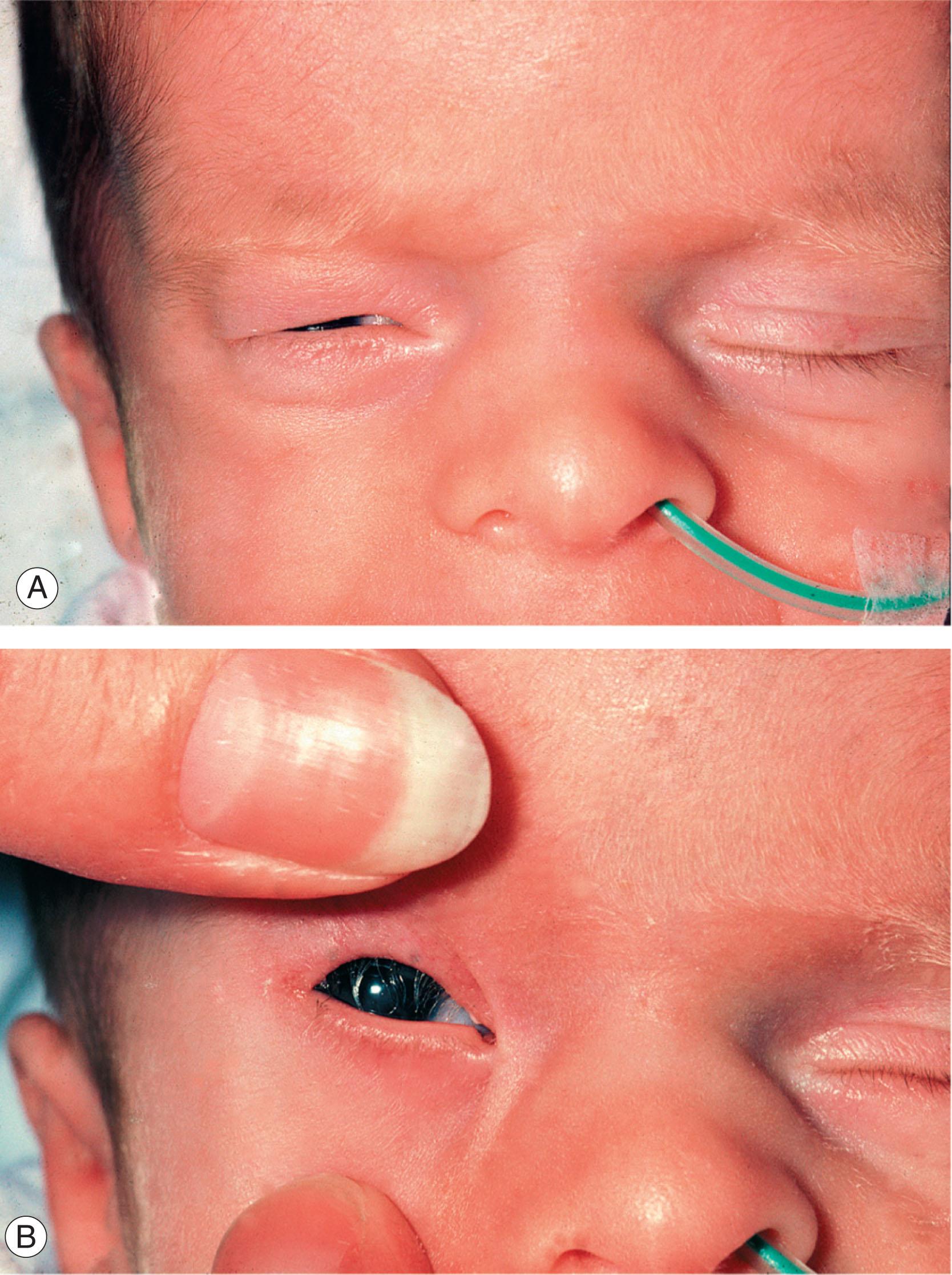
Congenital upper lid entropion is rare due to the relative stability and height of the superior tarsus. It is most often associated with a horizontal kinking of the tarsus. As with lower lid entropion, there is a risk of corneal scarring and infection. It can be corrected by incising the tarsus along the kink, and rotating the eyelid margin to the correct position ( Fig. 17.8 ).

Distichiasis is a developmental abnormality in which a second row of cilia emerges from meibomian gland orifices posterior to the normal eyelashes ( Fig. 17.9 ). The abnormal lashes may be asymptomatic or cause superficial corneal problems. If the patient is symptomatic or has significant corneal staining, treatment is indicated. Electrolysis is the treatment of choice, but is time consuming and has a high failure rate unless the lash roots can be exposed and ablated under direct visualization. A small, partial-thickness, vertical cut may be made through the conjunctivalized surface of the tarsus in order to expose the whole eyelash from the lid margin to the lash root. It is then electrolyzed under direct visualization. An alternative to address large numbers of lashes is cryotherapy with a double freeze–thaw cycle. A gray line split between the anterior and posterior lamellae allows cryotherapy to be applied directly to the tarsus, avoiding damage to the normal lash roots and, in dark-skinned patients, discoloration of the skin. The anterior lamella may then be recessed, leaving the raw surface of the tarsal plate to granulate.
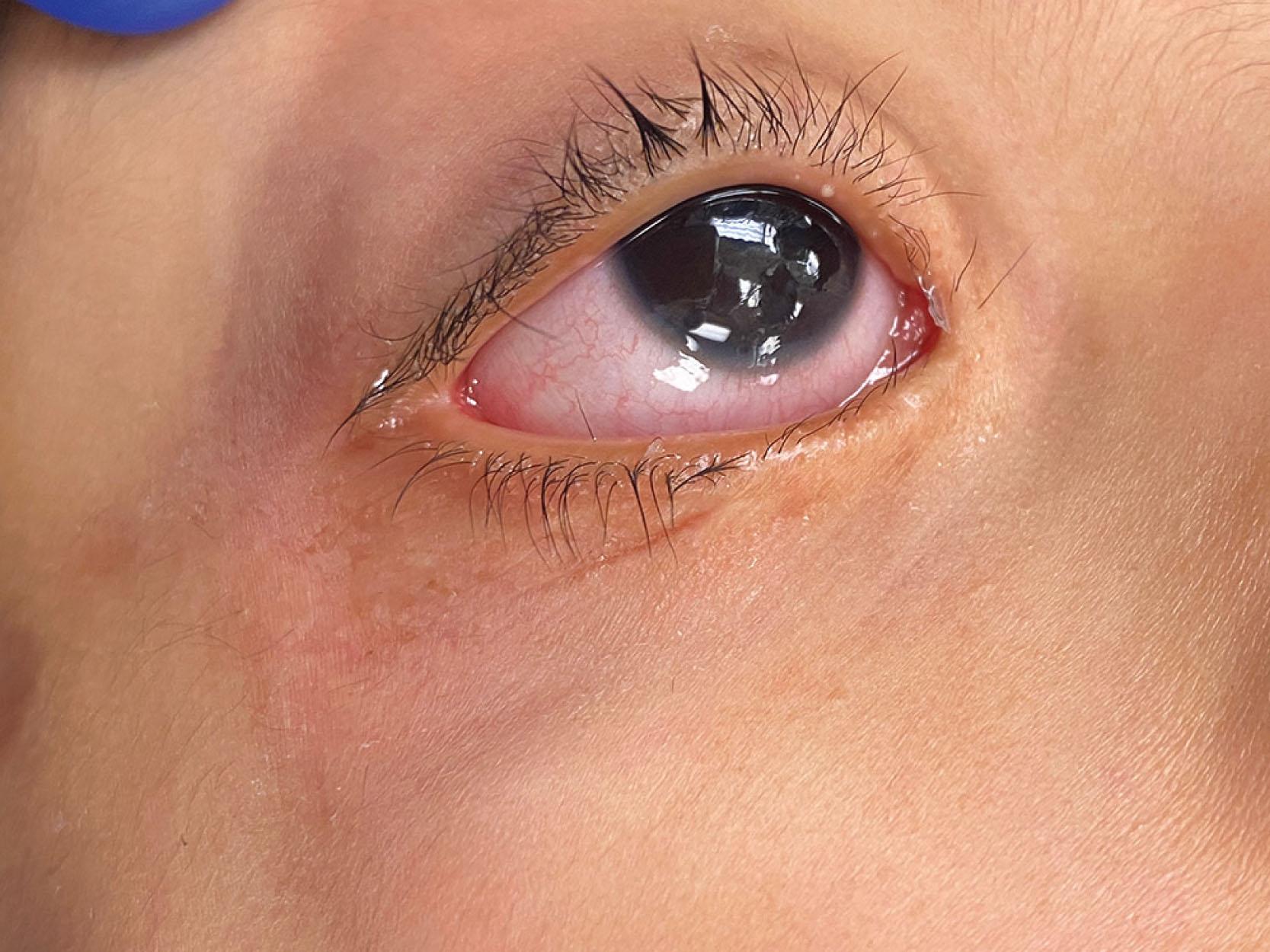
Telecanthus is an increased distance between the medial canthi, with a normal interpupillary distance ( Fig. 17.10 ). If there is a true increase in the interorbital and interpupillary width the condition is referred to as hypertelorism. Telecanthus can usually be improved by shortening the medial canthal tendons without altering the underlying bony structure. Mild cases can be treated by medial canthal plication with a non-absorbable or wire suture combined with a Y–V-plasty. More severe cases may require transnasal wiring combined with a Y–V-plasty. The thickness of the anterior lacrimal crest and medial orbital wall bone can be reduced with a burr as needed. If a transnasal wire is required, it is essential to have preoperative radiologic confirmation of the height of the cribriform plate to avoid an iatrogenic cerebrospinal fluid leak or damage to intracranial structures. The correction of hypertelorism requires craniofacial surgery techniques to mobilize the orbital rims and reduce the prominence of the intervening ethmoid bones.
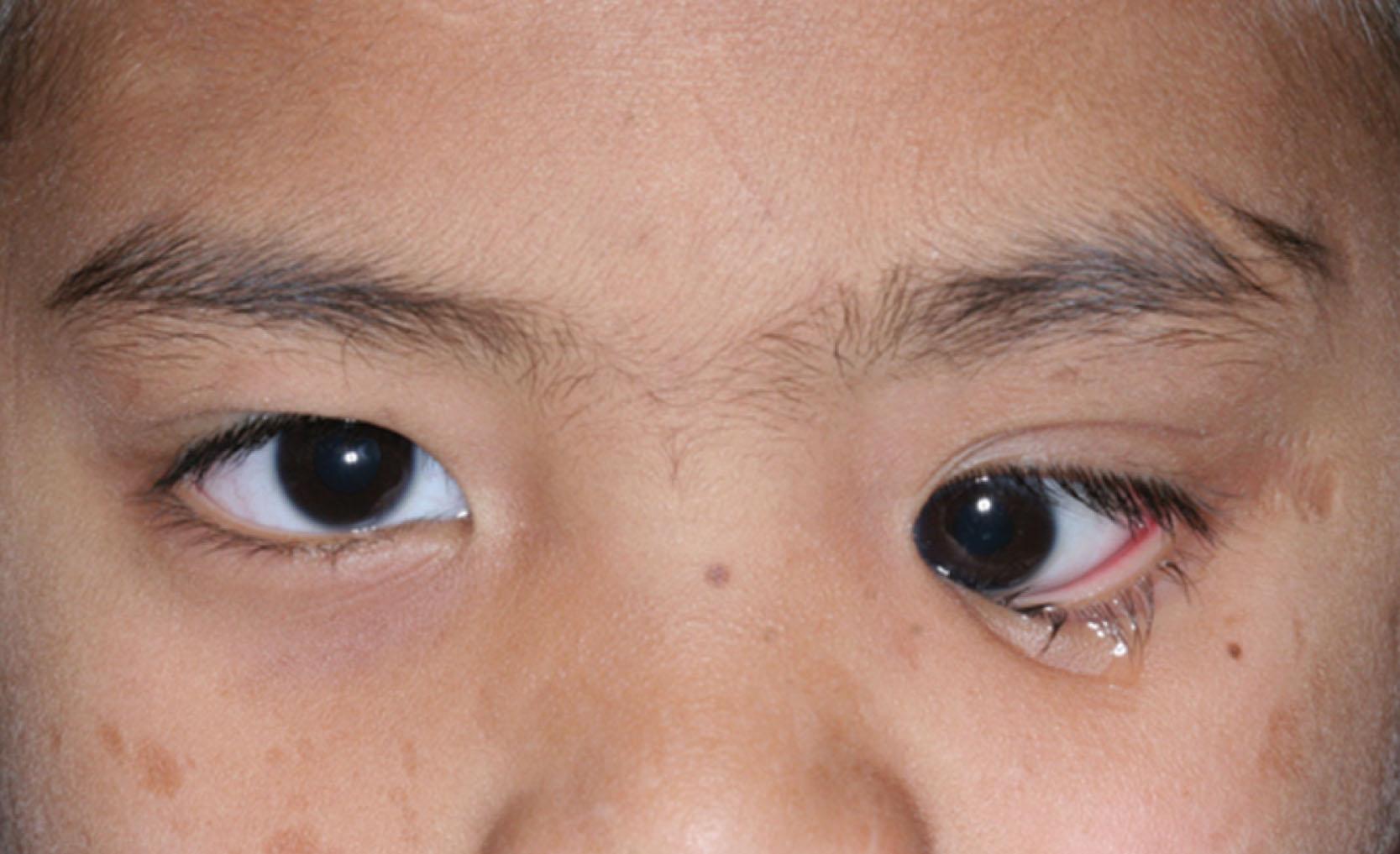
Blepharophimosis–ptosis–epicanthus inversus syndrome (BPES), or blepharophimosis syndrome, involves shortening of the horizontal fissures and is associated with telecanthus, severe ptosis, and epicanthus inversus. Careful attention to the detection and treatment of strabismic deviations is also warranted. BPES is caused by a mutation in the FOXL2 gene located on chromosome 3. The ptosis is always bilateral and the levator function is typically poor.
When ptosis is not amblyogenic, surgical treatment is frequently performed in a sequential manner with initial correction of the epicanthic folds followed by ptosis surgery with frontalis slings or muscle advancement due to poor levator function ( Fig. 17.11 ). Favorable results from simultaneous double Z-plasty and levator muscle resection have also been described.

Various techniques have been described to rearrange the medial canthal tissues, but a simple Y-to-V advancement with medial canthal tendon plication, or, in the case of more severe telecanthus, transnasal wiring is most effective. The epicanthic folds can be corrected at the same time or left until the bridge of the nose has developed during puberty, which may by itself improve the cosmesis.
True congenital ptosis can occur unilaterally or bilaterally and is classified as myogenic or neurogenic. Typical signs of congenital ptosis include a unilateral or bilateral ptotic eyelid with decreased vertical palpebral fissure height, shallow or absent eyelid crease, elevated ipsilateral brow, lid lag on downgaze, or chin-up position. Congenital myogenic ptosis is usually due to dysgenesis of the levator palpebrae superioris muscle with fatty infiltration of the muscle. It can occur in isolation or as part of BPES. Due to localized levator muscle dysgenesis, there is a decrease in the total number of muscle fibers with resultant diminished levator contractility (resulting in ptosis); fatty infiltration also causes diminished muscle relaxation hence the characteristic lid lag in downgaze. The degree of ptosis can range from mild to severe. Congenital ptosis can also be neurogenic in nature due to congenital third cranial nerve palsy or congenital Horner syndrome.
Acquired ptosis etiologies in the infant and pediatric populations can be aponeurotic, myogenic, neurogenic, traumatic or mechanical. Acquired aponeurotic ptosis is due to dehiscence of the levator aponeurosis from its pretarsal insertion and the eyelid crease may be elevated. This can occur due to birth trauma or from repetitive mechanical stretching of the eyelid as seen with frequent eye rubbing, contact lens insertion, or multiple eye surgeries with the use of a lid speculum.
Causes of acquired myogenic ptosis include myasthenia gravis, chronic progressive external ophthalmoplegia, muscular dystrophy, and oculopharyngeal dystrophy. Acquired neurogenic ptosis is due to interruption of innervation and is usually secondary to acquired third nerve palsy, Horner syndrome or myasthenia gravis. The presence of ptosis with associated miosis (anisocoria worse in the dark) and iris heterochromia should prompt radiographic evaluation of the sympathetic chain. Other causes of acquired ptosis also include mechanical ptosis caused by eyelid edema or a mass, and traumatic ptosis (discussed later in this chapter).
Become a Clinical Tree membership for Full access and enjoy Unlimited articles
If you are a member. Log in here